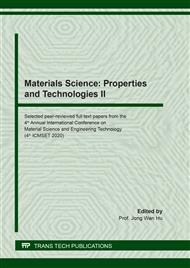p.1
p.7
p.12
p.17
p.22
p.28
p.35
p.40
The Effect of pH Values on Color Development of Silver Colloids
Abstract:
This study aimed to investigate the effect of pH value raging from pH 4 - 8 on color development of silver colloids. Silver colloids with different colors were synthesized by chemical reduction method using NaBH4 as a reducing agent and then adjusted pH value by adding dropwise of acetic acid. These silver colloids were characterized by Transmission Electron Microscopy and UV-Vis spectrophotometer. The results showed that the colors of silver colloids ranging from blue to yellow depended on amount of NaBH4 added. Due to Localized Surface Plasmon Resonance (LSPR) properties, different shapes and sizes of silver nanoparticles resulting in different colors. It was found that the pH value also affected color development of silver colloids. By adjusting the pH value, the colors of silver colloids changed to different colors or shades, which were clarified by the changes in the center as well as intensity of the absorption spectra. Moreover, the silver colloid in an acidic condition led to aggregation of nanoparticles.
Info:
Periodical:
Pages:
17-21
Citation:
Online since:
September 2020
Price:
Сopyright:
© 2020 Trans Tech Publications Ltd. All Rights Reserved
Share:
Citation:


